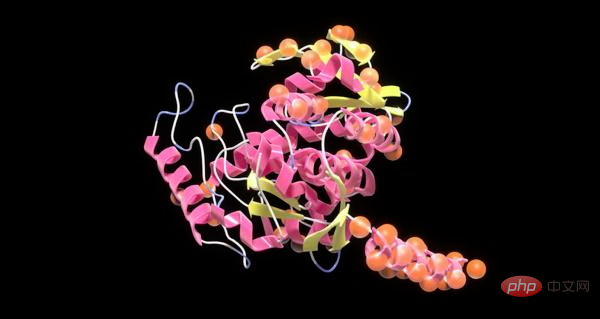Home >Technology peripherals >AI >Endless Possibilities NVIDIA Generative AI Model Speeds Protein Synthesis
Endless Possibilities NVIDIA Generative AI Model Speeds Protein Synthesis
- 王林forward
- 2023-04-13 16:07:03902browse
Over the past two years, machine learning has revolutionized protein structure prediction. Now, artificial intelligence has triggered a new round of revolution in the field of protein design.
Since the advent of AI, many scientists have joined the track of using it to conduct protein research. Biologists have discovered that using machine learning, protein molecules can be created in seconds. In the past, this time might have been several months.
Recently, the start-up Evozyne used pre-trained AI models provided by NVIDIA to create two proteins with significant potential in the medical and clean energy fields. One of the proteins is used to treat a congenital disease, and another is used to consume carbon dioxide to reduce global warming.

So scientists use NVIDIA BioNeMo to create large language models that generate high-quality proteins to speed up drug development and help create a more sustainable environment.
New ways to accelerate drug discovery
Andrew Ferguson, co-founder of Evozyne and co-author of the paper, said: “It is gratifying that this AI model has produced the first round of production. The resulting synthetic proteins are just like naturally occurring proteins, indicating that the model has learned nature's design rules."
Evozyne uses NVIDIA's ProtT5. ProtT5 is a Transformer model that is part of NVIDIA BioNeMo, a software framework and service for creating medical AI models.
Molecular engineer Ferguson, whose research fields include chemistry and machine learning, said: "BioNeMo is very powerful and allows us to train a model and then use the model to run work tasks at a very low cost, in a matter of seconds. Millions of sequences can be generated in minutes. The model predicts how to assemble new proteins that meet Evozyne's needs."
The model is at the heart of the Evovyne ProT-VAE pipeline. Evozyne’s ProT-VAE pipeline combines the powerful Transformer model in NVIDIA BioNeMo with variational autoencoders (VAEs).
He said: "A few years ago, no one noticed that you could use large language models combined with variational autoencoders to design proteins."
In contrast, Evozyne's method can change half or more of the amino acids in a protein in just one round. This amounts to hundreds of mutations.
Evozyne data scientist Joshua Moller said: "They speed up training by extending the work to multiple GPUs.
This reduces the time to train large AI models from months to a week "So we can train models that would otherwise be impossible to train," Ferguson said, "such as models with billions of trainable parameters. ”
Revolutionary AI Model
The traditional protein engineering design method, namely directed evolution, uses a slow, unplanned approach, usually just one protein at a time. Change the sequence of a few amino acids. Machine learning helps to study a large number of possible amino acid combinations and then effectively identify the most useful sequences.
BioNeMo is an AI-enabled drug development built on NVIDIA NeMo Megatron Cloud service and framework for training and deploying large biomolecule Transformer AI models at supercomputing scale. Services include pre-trained LLM, native support for common file formats for proteins, DNA, RNA and chemistry, and also provides support for SMILES ( Data loader used by (for molecular structures) and FASTA (for amino acid and nucleotide sequences).
With BioNeMo, scientists can start easily using pre-trained models, automatic downloaders and Preprocessor. With unsupervised structured learners, various models, embeddings, and outputs are combined to combine multimodal data. Unsupervised pretraining also eliminates the need for labeled data, allowing for rapid generation Learned embeddings predict protein structure, function, cellular location, water solubility, membrane binding, conservation and variable regions, etc.
Among them, MegaMolBART is a method that uses 1.4 billion molecules (SMILES string ), which can be used for a variety of chemical informatics applications. Moreover, BioNeMo provides Transformer-based protein language models such as ProtT5 and ESM1-85M.
BioNeMo also provides OpenFold, which is a user-friendly A deep learning model for predicting the 3D structure of novel protein sequences.
NVIDIA's Transformer model reads the amino acid sequences in millions of proteins. The model uses the technology used by neural networks to understand text and learns how to How nature builds protein amino acid sequences.
Looking to the future, the prospects of using AI to accelerate protein engineering are very broad. Artificially designed proteins are more stable than proteins that originally exist in nature and can survive without energy or One of its functions can also be realized under extreme conditions such as high temperature.
In addition, artificial intelligence can also be used to design amino acid sequences to match the backbone, which can be used to improve the stability of specific proteins such as enzymes and antibodies. Artificial intelligence technology plays a very important role in the design of proteins of different sizes and different conformations. In the future, it can also help design more and more useful proteins, including new biological materials that can be used to reduce pollution and improve the environment.
The above is the detailed content of Endless Possibilities NVIDIA Generative AI Model Speeds Protein Synthesis. For more information, please follow other related articles on the PHP Chinese website!
Related articles
See more- Technology trends to watch in 2023
- How Artificial Intelligence is Bringing New Everyday Work to Data Center Teams
- Can artificial intelligence or automation solve the problem of low energy efficiency in buildings?
- OpenAI co-founder interviewed by Huang Renxun: GPT-4's reasoning capabilities have not yet reached expectations
- Microsoft's Bing surpasses Google in search traffic thanks to OpenAI technology

